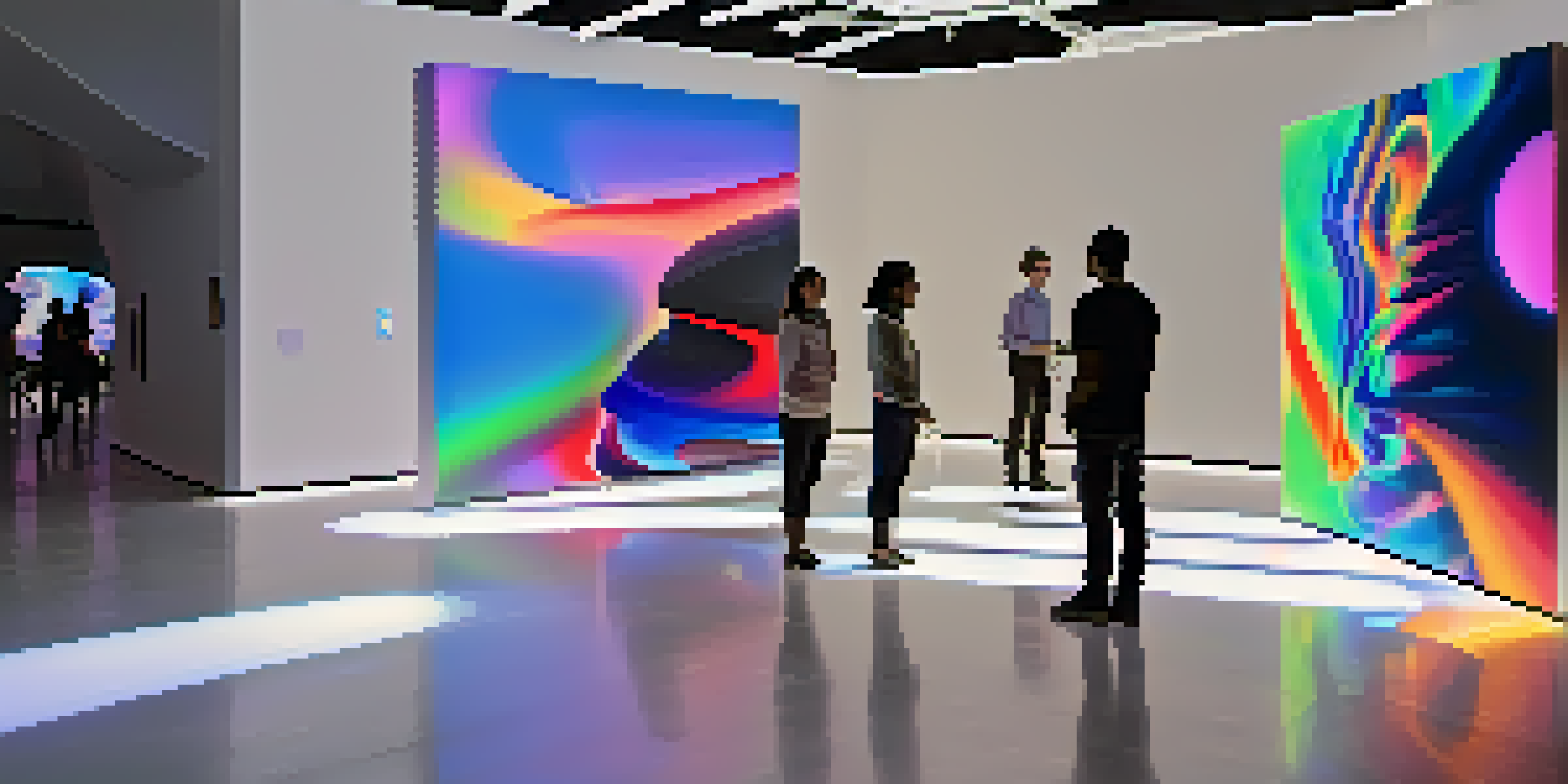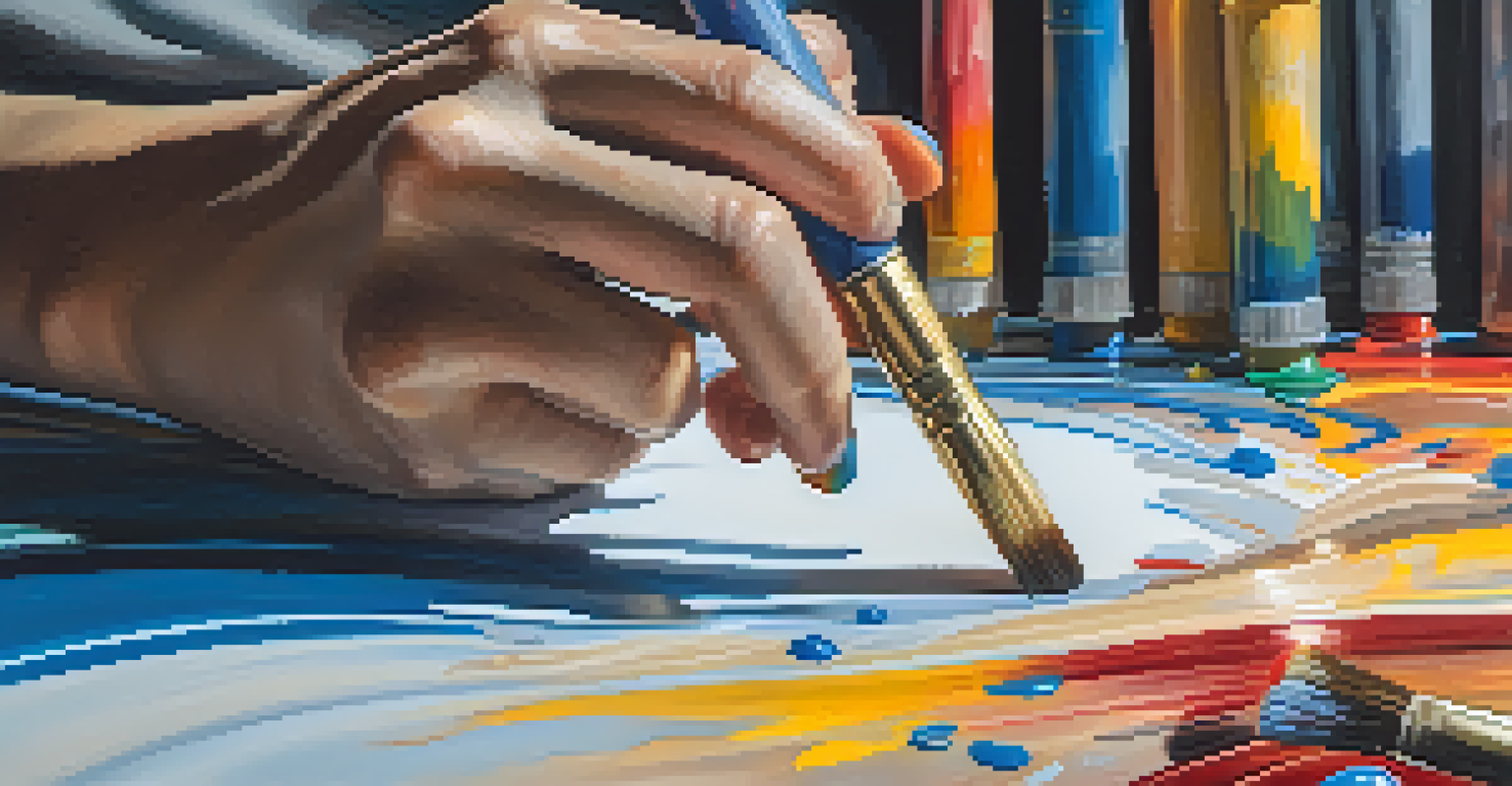The Connection Between Art and Memory in Human Experience

The Intrinsic Link Between Art and Memory
Art and memory share a profound relationship, where each can shape the other. When we engage with art, whether through painting, music, or literature, we often find ourselves transported to different times and places. This connection allows our memories to become more vivid and emotionally resonant, as art can evoke feelings tied to specific moments in our lives. In essence, art acts as a vessel that carries the weight of our experiences, enhancing our recollections.
Art is not freedom from discipline, but disciplined freedom.
Consider a simple childhood drawing, perhaps of a family picnic. The colors, the shapes, and even the imperfections can bring back a rush of emotions and details that might otherwise fade. This phenomenon illustrates how a single piece of art can unlock a treasure trove of memories, serving as a catalyst for nostalgia. Therefore, the creation and appreciation of art can significantly enrich our memory landscape, intertwining our past with our present.
Moreover, research in psychology has shown that visual stimuli can activate various parts of our brain associated with memory recall. When we see artwork, our brains engage in a complex dance of recognition and association, which helps solidify memories. This interaction not only highlights the importance of art in preserving our individual histories but also emphasizes its role in collective memory, shaping how societies remember and recount their narratives.
How Art Stimulates Emotional Memory
Emotions play a critical role in how we remember experiences, and art has a unique ability to elicit these feelings. When we encounter a powerful painting or a moving piece of music, our emotional response can be immediate and intense. This emotional engagement helps anchor our memories, making them more distinct and accessible than neutral experiences. Essentially, art transforms ordinary moments into emotionally charged memories that we carry with us.

For example, think about a song that reminds you of a significant life event, like graduating from school or a wedding. The melody and lyrics can evoke a cascade of emotions, transporting you back to that specific moment in time. This is why many people associate certain songs with particular memories; the emotional resonance of the music acts as a trigger for recall. Thus, art doesn't just reflect our experiences; it actively shapes the emotional landscape of our memories.
Art Enhances Memory Recall
Art acts as a powerful vessel for memories, enriching our recollections and emotionally connecting us to our past experiences.
Additionally, this connection between art and emotional memory has been harnessed in therapeutic settings, where art therapy is used to help individuals process trauma. By creating or engaging with art, people can access difficult emotions and memories in a safe environment. This healing process underscores the power of art not only as a creative outlet but also as a profound tool for understanding and reconciling our past.
The Role of Art in Cultural Memory
Art serves as a crucial component of cultural memory, preserving and conveying shared experiences across generations. Through literature, visual arts, and music, societies can express their histories, values, and collective emotions. For instance, traditional storytelling often incorporates visual art forms, allowing communities to pass down lessons and memories that shape their identity. In this way, art becomes an archive of cultural memory, rich with significance.
Every artist dips his brush in his own soul, and paints his own nature into his pictures.
Take the example of historical paintings that depict pivotal events, such as wars or social movements. These artworks don't just illustrate the past; they invite viewers to engage with the emotions and narratives surrounding those moments. As people interact with these pieces, they develop a collective memory that informs their understanding of their culture and heritage. Art thus acts as a bridge, connecting individuals to their communal histories and shared identities.
In contemporary society, the interplay between art and cultural memory is more vital than ever. As cultures evolve and new narratives emerge, artists continue to reinterpret and challenge existing memories through their work. This dynamic relationship ensures that art remains a living expression of cultural memory, reflecting both the past and the present while shaping the future.
Memory as a Muse: Artists Inspired by Their Past
Many artists draw inspiration from their personal memories, using their past experiences to fuel their creativity. Whether through autobiographical elements or reflections on significant life events, artists often weave their memories into their work. This not only enriches their art but also invites viewers to engage with the underlying stories. In this sense, memory becomes a muse, guiding artistic expression and exploration.
For example, renowned painter Vincent van Gogh often incorporated elements of his life experiences into his works. His paintings, filled with emotional intensity, reflect his struggles and triumphs, resonating with viewers on a deep level. When we understand the memories behind the art, we gain insight into the artist's intentions, making the experience more profound. Thus, the connection between memory and art becomes a two-way street, where personal recollections enhance artistic creation.
Emotions Anchor Our Memories
The emotional responses elicited by art transform ordinary experiences into memorable moments, making them more distinct and accessible.
Moreover, this practice of translating memory into art can also serve as a form of catharsis for the artist. By revisiting and interpreting their past through their work, artists can process complex emotions and experiences, transforming pain into beauty. This transformative aspect of art highlights its role not just as a reflection of memory, but as a powerful tool for personal healing and growth.
The Impact of Memory on Art Appreciation
Our memories significantly influence how we perceive and appreciate art. When we encounter a piece of art, our previous experiences and recollections can shape our emotional responses and interpretations. This personal connection often adds layers of meaning, as we project our memories onto the artwork. Thus, the appreciation of art becomes a unique and individual experience, colored by our past.
Consider visiting an art gallery and coming across a painting that reminds you of a childhood memory. The nostalgia associated with that memory may evoke a strong emotional response, enhancing your appreciation for the artwork itself. In this way, our memories act as lenses through which we view art, making each interaction deeply personal. This personal lens allows for a richer and more varied understanding of artistic expressions.
In addition, the context in which we experience art can also influence our memory. For instance, viewing art in a serene environment versus a chaotic one can affect our ability to engage with it. This highlights the importance of the setting and our state of mind when it comes to forming lasting memories around artistic experiences. Ultimately, the interplay of memory and art appreciation creates a tapestry of individual experiences that enrich our understanding of creativity.
Art as a Tool for Memory Preservation
Art has long been recognized as a powerful method for preserving memories, both personal and collective. By capturing moments in time through various mediums, artists create lasting records that can be revisited and cherished. This function of art as a mnemonic device allows individuals and communities to hold onto their histories, ensuring that memories are not lost to time. In essence, art becomes a safeguard for our experiences.
Consider the role of photography, which allows us to freeze a moment in time and capture its essence. A photograph can evoke memories of a specific event, reminding us of the emotions we felt and the people we shared those moments with. Similarly, sculptures and murals can serve as physical reminders of significant events or figures in a community’s history. By engaging with such artworks, we reinforce our connections to the past and the memories they evoke.
Art Preserves Cultural Narratives
Through various forms, art serves as a crucial tool for preserving and conveying shared cultural memories across generations.
Moreover, the preservation of memories through art can extend beyond the individual, contributing to collective memory. Public art installations, such as memorials or community murals, serve to commemorate shared experiences and honor those who have come before us. These artistic expressions not only celebrate memory but also foster a sense of belonging and continuity within communities, making art an essential element of our collective narrative.
The Future of Art and Memory: A Digital Perspective
As we continue to evolve in a digital age, the relationship between art and memory is also transforming. Digital art forms, such as virtual reality and interactive installations, offer innovative ways to engage with memories and experiences. These contemporary mediums challenge traditional notions of art and invite audiences to participate actively in the storytelling process. This shift not only broadens the scope of artistic expression but also enhances our ability to connect with memories in new and exciting ways.
For instance, virtual reality experiences can transport individuals to important moments in history, allowing them to 'experience' events from the past. This immersive approach to art blurs the lines between memory and reality, creating a more profound emotional impact. By engaging with art in such dynamic ways, we may strengthen our connections to our personal and collective memories, ensuring they remain vivid and accessible.

Additionally, the rise of social media and digital storytelling platforms has democratized art creation and memory sharing. Individuals can now document their lives and experiences through various artistic expressions, allowing for a broader and more diverse representation of memories. This shift signifies a powerful change in how we relate to art and memory, as the boundaries between artist and audience continue to blur, fostering a collaborative and inclusive approach to preserving our histories.